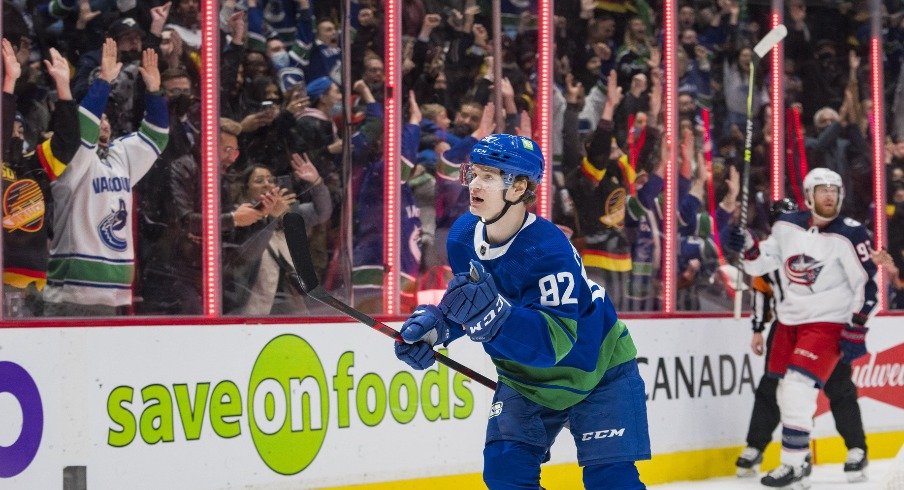In the last two games, the Columbus Blue Jackets have had leads of 4-1 in the third period and 3-0 in the second period.
Both opponents had (and still have) a losing record. Both opponents were (and still are) in the bottom half of the league in scoring.
And for the second straight game, the Blue Jackets' opponent climbed Mt. Comeback to walk away with at least a point.
Columbus makes one hell of a Sherpa.
Saturday, the Blue Jackets allowed the Seattle Kraken to score three goals in the final period to send the game to overtime. With momentum entirely in favor of the Kraken, it took a poor effort from Seattle goalie Philipp Grubauer in the extra period on a Jake Bean shot (MoneyPuck gave the shot just a 7.1% chance of going in) that allowed Columbus to escape with a 5-4 victory.
In Tuesday's collapse, Columbus turned the 3-0 lead into a 4-3 regulation loss to the short-handed Vancouver Canucks, who were without several players due to COVID-19 protocols. Even after the game was underway, defenseman Tucker Poolman was pulled from the ice and placed in protocol.
Canucks' Poolman exits mid-game as team says he has been placed in league protocol https://t.co/owNooueQ7b
— CBC British Columbia (@cbcnewsbc) December 15, 2021
You'd think it was Columbus playing down, though — and as soon as the game became 3-1 in the second period, it felt like the Blue Jackets were merely trying to run out the clock. It's not the first time this season they've done that, and Tuesday was not the first time this season it's come back to bite them.
The Blue Jackets had just five shots on goal in the second period. Two of them came in the first 7:41 of the period, before Vancouver's Bo Horvat scored to cut the Columbus lead to two. It took nearly ten minutes of game play after Horvat's goal for the Blue Jackets to generate the first of their final three shots in the period on Canucks goalie Jaroslav Halak.
When they would get their first shot on goal in the third period, more than halfway through the frame, the Blue Jackets found themselves in a 3-3 game, and a tie game had never felt so over. Sure enough, with one minute left in the game, what we knew was coming, came. Vancouver took the lead on a power play goal, Columbus couldn't get the equalizer in the final seconds, the Canucks won their fifth straight game in what was also their largest comeback of the season, and the Blue Jackets let another two points slip through their fingers.
Bo Horvat redirects home the gorgeous pass from J.T. Miller to finish off the comeback for Vancouver!#Canucks pic.twitter.com/mUmV8i3Uhs
— Hockey Daily 365 (@HockeyDaily365) December 15, 2021
For the game, Halak stopped 20 of 23 shots. Many of those 20 saves came with him scrambling for the puck after the save, unsure if he actually had it or not. Halak looked shaky, at best. It was the kind of performance makes one wonder if the Blue Jackets could have scored six or seven times if they wouldn't have gone into a shell.
How poor was Halak's play? Columbus had an expected goals total of 3.83. That's their seventh highest xGF of the year, despite their 23 shots being their fourth-lowest output of the year. That's about 0.16 goals per shot, which is 45% higher than their season average of 0.11. In other words, the opportunity for a big night in the goal column was there for the taking — all Columbus had to do was generate a minimal amount of offense.
Instead, Columbus tried to sit on a 3-0 lead for two periods of hockey. They had three shots on goal in the 23+ minutes between Vancouver making it a 3-1 game and tying it at 3-3. At that point, the game felt like it was over.
For an elite defensive team, relying on your defense and goaltending to preserve the lead is a fine strategy.
The Blue Jackets are not an elite defensive team. That strategy does not work for this team.
It was the best example to date — though by no means the only one — of a team that simply abandoned their game. Columbus rejected what was working in place of what didn't work Saturday in Seattle, and they did it again Tuesday in Vancouver.
The best way to keep a lead is to build on it.
The worst? We're seeing it.


